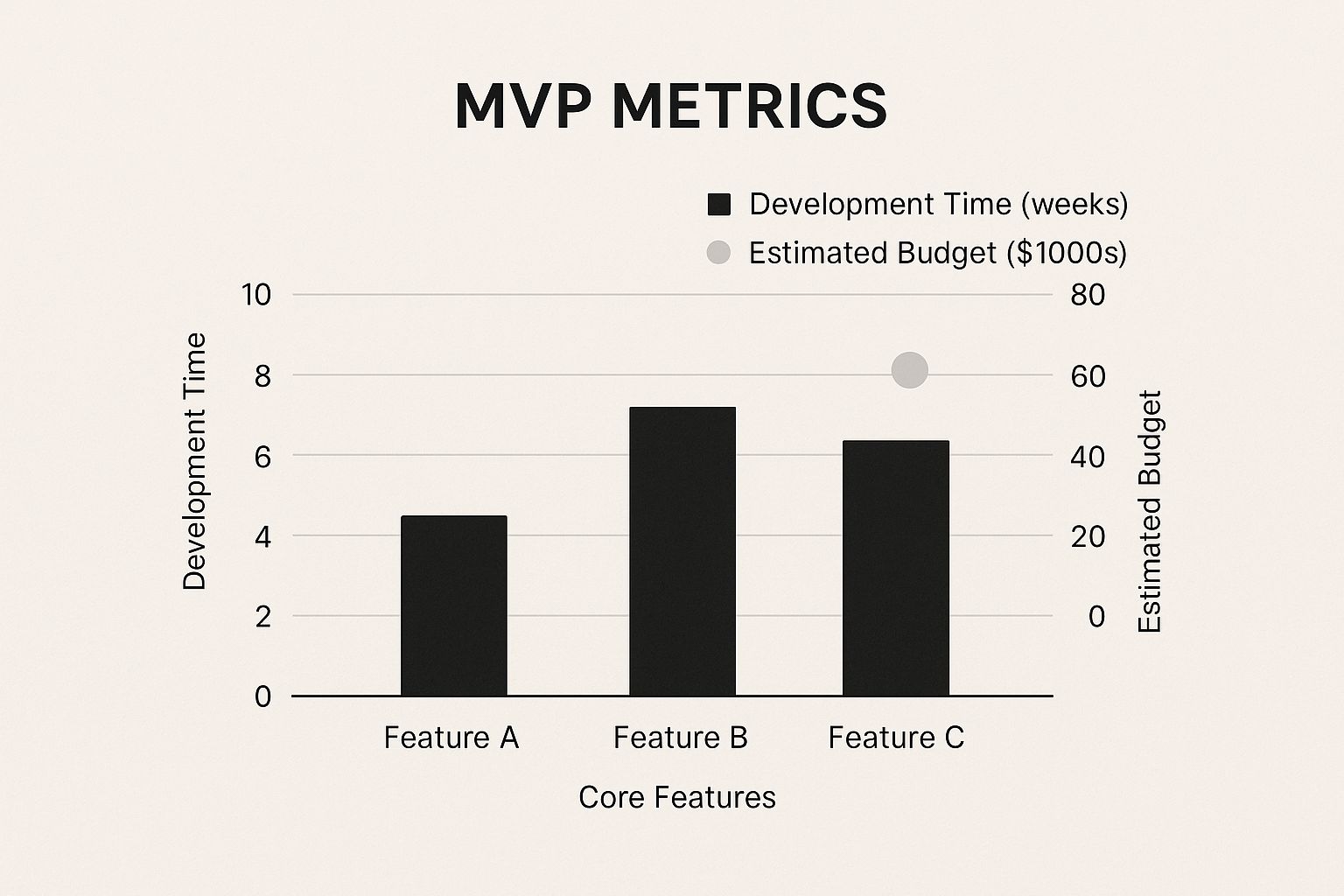Validate Startup Idea: Key Steps to Success


Learn how to validate startup idea effectively with proven strategies to reduce risk and ensure market fit. Turn your concept into a thriving business.
Why Most Founders Skip Validation (And Why You Shouldn't)

The entrepreneurial world thrives on new ideas. Founders are passionate about their vision. But many make a critical mistake: they skip idea validation. This can lead to wasted resources and ultimately, failure. Let’s explore why this happens, and why validating your startup idea is so important.
The Allure of the "Perfect" Idea
Many founders believe their idea is perfect, just as it is. They fear that outside feedback will somehow damage their original vision. This creates an echo chamber, where their own biases are reinforced. They become blind to potential problems and what the market actually wants.
Other founders are just eager to start building. They want to jump into the exciting parts of product development. They overlook the less glamorous, but essential groundwork of validation. This impatience can be a costly mistake.
The pressure to launch quickly is intense. No one wants to be “scooped” by the competition. But launching prematurely, without a validated idea, dramatically increases the risk of building a product no one wants. A validated idea is the strong foundation you need for a successful business.
Why Validation Is Your Startup's Insurance Policy
Validating your startup idea isn't just a box to tick; it's essential for success. A staggering 90% of startups fail. Many of these failures are due to a mismatch with the market, not problems with the product itself. A CB Insights study showed that 42% of startup failures happen because they build products no one wants. This statistic alone highlights the importance of early validation.
Tools like SANDBOX by PayPal (which uses simulations to validate ideas) can reduce idea failure rates by 73%. This shows the power of thorough validation before investing significant resources. For more eye-opening statistics on startup failure, check out this article: 19 Shocking Startup Failure Statistics - Female Switch
Validating your startup idea offers several key benefits:
- Mitigate Risk: Early testing helps you identify potential issues and adjust your strategy. This reduces the risk of wasting time and money on a flawed concept.
- Understand Your Target Audience: Validation provides insights into your target market’s needs and preferences. This helps you tailor your product or service to meet those specific demands.
- Refine Your Value Proposition: Validation helps you refine your message and clearly communicate the value you offer. This increases your chances of attracting and keeping customers.
- Secure Funding: Investors are more likely to support ventures with validated ideas. Validation demonstrates market demand and a higher likelihood of success.
Validating your idea changes how you approach risk. You make informed decisions based on data, not guesswork. You’re building your business on a solid foundation of customer understanding. This dramatically increases your chances of long-term success. It means moving away from a "build first, ask questions later" approach to a more strategic, customer-centric model.
The Unfair Advantage: Co-Founder Dynamics in Validation

Validating startup ideas can be a real challenge for solo founders. It often feels like trying to solve a puzzle with missing pieces. However, co-founder teams have a significant advantage. They can approach validation as a shared journey of discovery, bringing diverse perspectives and skills to the table.
Leveraging Disagreements as a Validation Tool
One of the most valuable assets of a co-founder team is the opportunity for healthy disagreement. While disagreements might seem negative, they can be a powerful validation tool when handled correctly. For example, imagine one co-founder has a marketing background, while the other is a product development expert. Their different viewpoints can uncover potential weaknesses and push the idea towards a stronger, more market-ready solution. This dynamic fosters thorough examination of assumptions and a more realistic assessment of potential obstacles.
This doesn't advocate for constant arguing. Instead, using structured debate frameworks can be helpful. These frameworks can channel disagreements into productive conversations, strengthening the validation process. By creating clear guidelines for sharing opposing viewpoints, co-founders can keep their debates focused and constructive. This approach turns disagreement from a potential source of conflict into a valuable resource for refining the startup idea.
Another important factor in startup validation is the presence of co-founders. Startups with co-founders statistically tend to have better success rates than those with solo founders. This is because partnerships increase accountability and distribute risk and workload more evenly. Co-founders can provide diverse perspectives and skills, helping identify potential problems early on. In fact, the success rate for first-time startup founders is only around 18%, highlighting the importance of collaboration and shared knowledge. More detailed statistics can be found here.
Strategic Division of Responsibilities and Network Leverage
Co-founders can strategically divide validation tasks according to their strengths. One co-founder might excel at customer interviews, while another shines at market research. This division of labor leads to more effective and targeted validation efforts. Furthermore, co-founders can tap into their combined networks. Gathering feedback from a larger network provides a wider perspective on the startup idea and can uncover valuable insights that might otherwise be missed.
Avoiding Echo Chambers and Maintaining Objectivity
While co-founder teams offer distinct advantages, it’s crucial to avoid creating an echo chamber. Seeking external perspectives outside the founding team is essential for staying objective. This involves engaging with potential customers, industry experts, and mentors for unbiased feedback. This outside input helps challenge internal biases and ensures a realistic validation process. This balanced approach – combining the internal strengths of a co-founder team with external feedback – greatly increases the chances of developing a truly validated and successful startup idea. Tools like Business Ideas DB can provide additional inspiration and insights into market needs, further enhancing the validation process.
Validation Metrics That Actually Predict Success

Not all validation signals are created equal. While positive feedback is encouraging, identifying metrics that genuinely predict startup success is crucial. This means focusing on indicators that demonstrate real market demand and potential for sustainable growth, not just initial enthusiasm. This section explores the key validation metrics that separate promising startup ideas from those unlikely to succeed.
Qualitative Vs. Quantitative Validation Markers
Effective validation relies on combining qualitative and quantitative data. Qualitative validation focuses on understanding why customers might use your product. It delves into their pain points, motivations, and desired outcomes. This often involves customer interviews, focus groups, and analyzing open-ended survey responses.
For example, imagine a startup developing a new project management tool. Qualitative data might reveal customer frustration with existing tools due to complexity or missing features. This information is invaluable for shaping product development.
Quantitative validation provides numerical data measuring the extent of customer interest and potential market size. This can include metrics like website traffic, landing page conversion rates, and pre-orders. Validating a startup idea also involves assessing product-market fit and customer demand.
A significant number of startups fail from a lack of product-market fit, around 34% of small businesses. About 22% fail due to inadequate marketing. To mitigate these risks, entrepreneurs use business model validation tactics, like ad click-through rates, to gauge product interest. A good click-through rate ranges from 2-5%, indicating strong interest and potential. These methods help startups understand their target market and refine their offerings. Find more detailed statistics here. Combining qualitative and quantitative data provides a holistic view of your startup’s potential.
Measuring Customer Behavior, Not Just Intentions
Successful validation focuses on actual customer behavior rather than stated intentions. While customers may express interest, their actions determine success. For example, many free trial sign-ups are positive, but real validation comes from conversion to paying customers.
This means tracking metrics like customer acquisition cost (CAC), customer lifetime value (CLTV), and churn rate. These reveal whether your startup can attract and retain customers profitably. This focus on behavior highlights the difference between what customers say and do.
Interpreting Contradictory Signals and Pivoting Vs. Persevering
Validation rarely yields perfectly clear results. Startups often encounter contradictory signals. The ability to interpret data and make informed decisions becomes essential. Negative feedback can be as valuable as positive feedback, highlighting areas for improvement or potential pivots.
Knowing when to pivot or persevere is a critical skill. This requires carefully analyzing validation metrics, considering the feedback's magnitude and source. For example, widespread customer concerns about a specific feature may necessitate reconsideration. However, a few negative comments from a small group might not warrant a significant change. By objectively analyzing validation data, startups can refine their ideas and improve their chances of success. For more guidance, explore the resources at Business Ideas DB.
Zero-Budget Validation Techniques That Actually Work

The infographic above shows the development time and budget needed for three core MVP features. Feature A takes the least amount of time and money compared to Features B and C. This suggests starting with Feature A in your initial Minimum Viable Product (MVP) to quickly validate its value. This lean approach lets you gather crucial user feedback before spending more resources on less important features.
Validating your startup idea doesn't need a big budget. Many successful founders validated their concepts with limited resources, using ingenuity and direct customer interaction. This section explores proven zero-budget validation techniques to confirm market demand before heavy investment.
Creating High-Conversion Landing Pages
A simple landing page can be a strong validation tool. By focusing on a clear value proposition and call to action, you can test market interest without a fully functional product.
You could offer a free resource, early access to a beta version, or a waiting list signup. Tracking conversion rates gives valuable insights into customer demand.
Conducting Unbiased Customer Interviews
Talking directly to your target audience is essential. Customer interviews provide qualitative data, revealing real needs, pain points, and potential objections. Asking unbiased questions is key to avoid leading the conversation and skewing results.
Focus on open-ended questions encouraging honest responses, such as "What are your biggest frustrations with current solutions?" For more insights, check out this helpful article: How to master testing your business idea.
Building Paper Prototypes for Feedback
Even before digital development, paper prototypes can generate valuable feedback. These simple mockups let you quickly and cheaply visualize your concept and test user flows.
By observing how potential customers interact with these prototypes, you can find usability problems and refine your product design early.
Leveraging Existing Platforms
Online platforms are powerful validation tools. Social media groups, online forums, and marketplaces can gauge interest and gather feedback.
Engaging in relevant discussions, sharing your concept, and asking for opinions provides insights into market demand.
Learning From Bootstrapped Founders
Many successful bootstrapped founders validated their ideas before funding, proving validation isn't just about money. Studying their strategies teaches you to prioritize customer interaction and leverage free resources.
This resourcefulness enhances your validation efforts and sets the stage for a successful launch.
To help you compare different validation methods, take a look at the table below:
This table compares different methods for validating startup ideas based on cost, time investment, and feedback reliability.
Startup Validation Methods Comparison
| Validation Method | Cost Range | Time Investment | Feedback Reliability | Best For |
|---|---|---|---|---|
| Landing Page | Free - Low | Low - Medium | Medium | Testing value proposition & initial interest |
| Customer Interviews | Low | Medium - High | High | Understanding customer needs & pain points |
| Paper Prototypes | Very Low | Low | Medium | Early usability testing & design feedback |
| Online Platforms | Low | Medium | Medium - High | Gauging market interest & gathering initial feedback |
As you can see, different methods offer varying levels of cost, time investment, and feedback reliability. Choose the methods that best suit your current stage and resources. Combining multiple methods often provides the most comprehensive understanding.
Building an MVP That Validates (Not Just Impresses)
Many founders get excited about building. They pour their energy into creating a Minimum Viable Product (MVP) packed with features. But sometimes, they miss the main point: an MVP isn't about flash, it's about validating your startup idea. This section focuses on using your MVP as a validation tool.
Identifying Essential Functionalities
The most common MVP mistake is overbuilding. Instead of focusing on the core functions that deliver your value, founders often add "nice-to-haves." This can lead to wasted time and money, and slow down valuable feedback. Think of your MVP as an experiment. Isolate the key variables – your core assumptions – and test them. For example, a meal-planning app MVP might only need basic recipe search and meal scheduling, not grocery ordering or dietary tracking. For more examples, check out this article on Minimum Viable Product examples.
Designing Experiments Around Your MVP
A successful MVP needs validation metrics. You need to define success before you build. This means setting specific, measurable, achievable, relevant, and time-bound (SMART) goals. You might aim for a specific conversion rate on your landing page, a certain number of user sign-ups, or a defined level of engagement with core features.
The Overbuilding Trap and Rapid Iteration
Overbuilding can create a false sense of progress. It delays crucial feedback and makes it harder to change direction if your assumptions are wrong. Instead, focus on rapid iteration. Launch quickly, gather feedback, and iterate based on the data. This lets you adapt and refine your offering quickly. Remember, your MVP should evolve based on real-world use.
Translating Validation Findings Into Priorities
After gathering data, analyze the results. This might mean prioritizing features, changing your marketing, or even pivoting your entire business model. Use the data to make informed decisions and build a product that meets real market needs.
To help you understand validation, let's look at some key metrics. The table below, "MVP Success Indicators," outlines key benchmarks for validating your startup hypothesis.
MVP Success Indicators
| Validation Area | Success Indicator | Warning Sign | Action Needed |
|---|---|---|---|
| User Engagement | High usage of core features | Low or declining usage | Investigate user behavior and refine features |
| Conversion Rates | Meeting or exceeding target conversion rates | Low conversion rates | Analyze user flow and adjust messaging |
| Customer Feedback | Positive feedback on core value proposition | Negative feedback or feature requests outside core value | Prioritize core value feedback; consider future iterations for other requests |
| Churn Rate | Low churn rate | High churn rate | Identify churn reasons and address underlying issues |
The table summarizes how to track progress and identify potential issues. High user engagement and positive feedback on core features indicate you're on the right track. Conversely, low conversion rates or a high churn rate signal a need for further investigation and adjustments.
By focusing on validation, you transform your MVP from a side project into a powerful tool. The goal isn't a perfect product at first, but a validated foundation for a successful business.
Transforming Validation Into Execution: The Critical Pivot
Validating your startup idea is just the first step. It's like confirming there's gold in the hills – exciting, but the real work hasn't even begun. This section bridges the gap between validation and execution, guiding you on how to turn promising insights into a thriving business. This is the critical pivot where your validated startup idea transforms into a tangible reality.
Developing a Validation-Informed Roadmap
Your roadmap shouldn't be based on founder preferences, but on customer signals. Validation data provides a compass, pointing towards features, pricing, and marketing strategies that resonate with your target audience. This customer-centric approach ensures you're building a product people actually want, minimizing the risk of developing something that misses the mark.
For example, if your validation reveals strong demand for a specific feature, prioritize it in your development plan. Conversely, if feedback indicates confusion about your pricing model, revisit and refine it based on customer input. This iterative process keeps your roadmap aligned with market needs, maximizing your chances of success.
Maintaining the Validation Mindset as You Scale
As your startup grows, maintaining the validation mindset is crucial. This means establishing continuous feedback loops, actively seeking customer input, and adapting to evolving market needs. It's easy to become complacent after initial success, but the market is constantly changing.
Continuous validation ensures your product stays relevant and continues meeting customer needs as your business expands. Additionally, use your validation data to attract investment. Investors look for evidence of market demand and a strong understanding of the target audience.
Your validation findings provide this proof, demonstrating the viability of your startup and increasing your chances of securing funding. This data-driven approach builds investor confidence and positions your startup as a promising investment opportunity.
Building Your Initial Team and Avoiding Pitfalls
Use your validation findings to build your initial team. Identify the skills and expertise needed to address the challenges and opportunities revealed during validation. This strategic approach ensures your team is equipped to execute your vision effectively and address the specific needs of your target market.
However, even with a validated idea, pitfalls exist. One common mistake is feature creep, where startups add unnecessary features, deviating from the core value proposition validated by customers. Another is neglecting ongoing customer feedback, leading to a disconnect between the product and evolving market needs.
By prioritizing customer feedback, staying focused on your core value, and building a team aligned with your validated vision, you can avoid these common post-validation pitfalls and pave the way for sustainable growth. Successfully navigating this critical pivot sets the stage for long-term success, transforming a validated idea into a thriving business.
Ready to turn your validated startup idea into a successful business? Business Ideas DB provides a wealth of resources, including curated startup ideas, market analysis, and expert guidance to help you launch and grow your venture. Visit Business Ideas DB today to explore these resources and accelerate your journey to success.
Explore More Ideas
Want more ideas like this? Check out Business Ideas DB for consumer app ideas backed by market research.
Explore Ideas